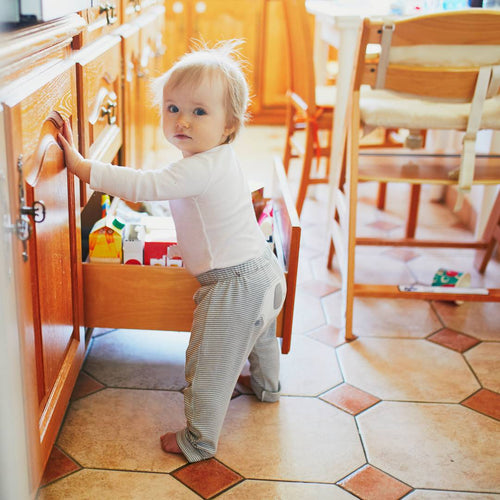When your baby first arrives, moving around is not really something they’re capable of. But the stage when they’re suddenly rolling and crawling can turn up very quickly, and it pays to be prepared beforehand so they can explore safely while still having every opportunity to learn. Today, we’ll look at a few of the things you can do around the house to keep your baby protected. Not all will apply to every household, and there may be other things you may want to include that aren’t in this list, but this should give you a good place to get started!
Furniture and Electronics
An excellent place to start (if you haven’t done this already) is making sure heavy furniture is well anchored. Bookshelves and dressers are common furniture items for babies to use to pull themselves up once they begin their transition from crawling to standing and walking, so making sure they’re well fixed to the wall is essential. This will stop your child accidentally pulling the furniture over on top of them. In the same vein, keeping any electronic or electrical appliance cords out of reach is important. This includes ensuring things such as phone chargers and kettle cords—anything little hands that are learning to explore can grab and pull—are well out of reach to avoid potentially causing injuries.
This also extends to the bigger appliances in the house. Standalone ovens should be fixed to the wall to prevent them tipping if a child climbs on them, and things like microwaves and TVs should likewise be anchored as the risk of them being pulled over can be quite high.

Baby Gates
The baby gate is a key piece of equipment many new parents find vital. These are non-permanent gates that can be put pretty much anywhere in your house you want to block off from adventurous crawlers and toddlers, such as stairs or entrances to places that can’t otherwise be adequately babyproofed. Get as many as you need (parents often find it useful to have a gate at the top and bottom of the stairs, for example), and get ones that fit the space properly. Many brands offer extenders if you have a wider-than-average space to fit them in, so check out the width of any hallways or doorways as well as the width of the gate you like the look of.
Drawers, Cupboards and Cabinets
If you have drawers or cabinets with hazardous items, get them securely locked before you need to. In this case, ‘hazardous items’ can include cleaning products, sharp objects (such as knives and scissors), medications, or anything else a baby shouldn’t be getting hold of. If there’s one thing babies love, it’s opening things up and putting them in their mouths, so removing that temptation entirely is the safest way to go. If the cupboards closer to the ground can’t be locked, consider moving any dangerous items they contain to higher spaces that baby can’t reach. This includes even things like vitamins or lotions – ingesting these can be much more harmful to small babies than some realise, as well as being a choking risk.

Electrical Sockets/Plugs
Electrical plugs can be very quickly and cheaply covered up with the use of power outlet covers. Any wall plugs that aren’t in use can have these put into them, keeping them safe from curious little fingers. Getting a cable tidy can be another option for outlets with things plugged into them. They’re not just great for keeping tiny fingers away – they’ll also keep your cables nicely organised!
Window Guards/Catches and Blind Cords
Babies are climbers. Once they start to pull themselves up, it’s tempting for them to climb everywhere, so some find it good peace of mind to have catches on their windows, especially for those windows on floors that are above ground level. In conjunction, keeping those cords out of the way is crucial if you have blinds. Blind cords constitute a significant risk factor for injury in toddlers, as they cannot free themselves if caught. Switching to cordless is the best idea, but if that’s not possible, make sure to keep the cords tied up well out of the way.

Small Objects
Another baby universal? They love putting things in their mouths. It’s a big part of how they learn about their environment and the things in it. Unfortunately, that also dramatically increases the risk of them choking. Keep small things like coins, toys that aren’t toddler-safe (marbles and the like are especially dangerous), button batteries, or other items of comparable size off the floor and up out of reach. This will probably have to be a daily task, especially if you have other children around.
Keep Your Eyes Open
The best way to keep your child safe is to actively supervise them. Babies often move with surprising speed once they’re independently mobile, and no matter how safe you’ve made your home, they often find a way to get themselves into places they shouldn’t! Nothing can replace keeping an eye on your little one, and it will also help cover those gaps that just can’t be foreseen.
What babyproofing looks like to you will vary, depending on your needs, your baby’s needs, and your home environment. What is necessary in one place may not be in another, so work around how things are for you. And as your child’s abilities change, the type of babyproofing you need will also change – it’s not a static, once-and-done process. Watch your baby, keep them safe, have fun and let them explore as their abilities allow!

